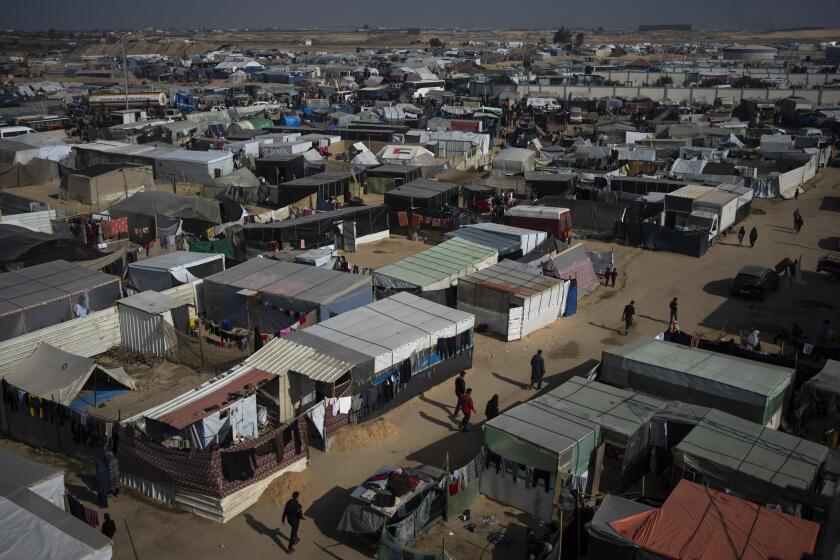TV AND THE GULF WAR : There’s Little TV News Without a Spin
First the sin, then the spin. The problem, on some days, is telling one from the other.
Television, which always brings us great spectacles, has been largely an outsider along with the rest of the media in conveying the heat of the Persian Gulf War. But this week’s TV pictures of scores of dead and disfigured Iraqi civilians being hauled from a Baghdad structure hit by U.S. bombs were by far the most horrifying sights from the war to date.
Iraq claimed the structure was a bomb shelter that the U.S. hit at night--knowing it was occupied by civilians. The United States claimed that it was an Iraqi command-and-control center. It insisted that it hadn’t known civilians were inside, implying they may have been installed there as human sacrifices in a propaganda scheme.
Not that it made any difference to the victims. As Pentagon briefer Lt. Gen. Thomas W. Kelly said Thursday: “They still put erasers on pencils, and human beings are human beings.”
And just as pencils have erasers, so do politically volatile times have spin doctors, whether the man in the street--”Down with Bush!” angry Baghdad crowds shouted on TV Thursday--or the man in the studio.
Interpreting events produces a kind of spin. Commenting on Western journalists’ eyewitness reports that the roof of the bombed bunker bore none of the camouflage described by the Pentagon, for example, ABC military analyst Tony Cordesman argued that the camouflage would have been scraped off by the bombing.
On CNN, military analyst Perry Smith, a retired major general, scrutinized a freeze-frame of the bunker’s ground-level exterior, noting various things that he said showed it was off limits to the public. So no bomb shelter.
CBS’ Charles Osgood indicated in a commentary that he believed the Pentagon’s story that it was unaware of civilians being in the bombed structure. “Watch out for that little thing you don’t know,” he said. “It’ll get you every time.”
The most bloodless diagnosis of the bunker attack came from TV-blitzing military analyst Edward Luttwak. Every bomb hitting a civilian “is a bomb wasted,” said Luttwak, as if describing spitballs.
It was Pentagon briefer Kelly’s blend of compassion (“I feel deeply, deeply sorry for these people”) and hard-line skepticism (“This has the feel of a propaganda thing to it”) that epitomized much of the reaction to the bombing as expressed on TV.
Noting that the tightly censored foreign press in Baghdad is rarely allowed freedom of movement, Kelly wondered why the Iraqi government doesn’t take the media “to Kuwait city to see the deprivation there and show it to the world.”
Earlier Thursday, in fact, a Kuwaiti military spokesman seemed anxious to undermine sympathy for Iraq over the bombing when he described atrocities against Kuwaitis who he said “had their throats cut and heads removed from their bodies” by Iraqi troops.
Some TV pundits, such as CNN’s “Crossfire” co-host Pat Buchanan and KABC commentators Bruce Herschensohn and John Tunney, prefer that American viewers not see civilian deprivation in Iraq. Buchanan argued Wednesday that showing the bombing pictures undermined the U.S. war effort, apparently feeling that Americans are not intelligent enough to watch these scenes and draw their own conclusions.
And said Herschensohn on Thursday, with Tunney concurring: “This is a time for those TV journalists to get out of there. They are a propaganda arm of Saddam Hussein. They are not reporting news.”
If scores of Iraqi civilians dying in a U.S. bombing raid for whatever reason is not news, then the Persian Gulf War is not news.
And Scuds are not news.
The shocking omission from TV’s bombing aftermath was a general absence of comment about the Scud missiles that Iraq has been aiming at Israeli civilians. If the Iraqis had better weapons or the Israelis weaker defenses, the Baghdad bunker holocaust would have been multiplied manifold in Tel Aviv.
It was Gulf War supporter Charlton Heston--while debating the conflict with war opponent Jerry Brown in a “Donahue” episode on KNBC on Thursday--who asked why everyone seemed to have forgotten those Scud attacks. But his question evaporated like smoke and went unanswered.
Thursday’s propaganda war accelerated, meanwhile, with the Iraqis rejecting reports that a military communications center was hidden beneath the Rashid Hotel, temporary home in Iraq to foreign media and other civilians. The hotel manager denied it to CNN’s Peter Arnett, but what else would he say?
The Iraqis took the press on a tour of the hotel and, said Arnett, “opened all steel doors on demand.” Earlier, Arnett had said the Iraqis opened “most” doors. Did the difference in wording mean anything, or was it inadvertent?
Both Arnett and ABC’s Bill Blakemore said they saw no evidence of a hidden communications center in the hotel. That afternoon, the Pentagon’s Kelly said about press reports from Iraq: “The easiest thing I can think of is to dupe reporters.” It’s something to contemplate while evaluating news from both sides.
Meanwhile, pick your spin.
More to Read
Sign up for Essential California
The most important California stories and recommendations in your inbox every morning.
You may occasionally receive promotional content from the Los Angeles Times.






